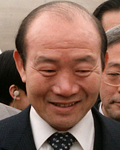1981 South Korean legislative election
| |||||||||||||||||||||||||||||||||||||||||||||||
All 276 seats in the National Assembly 139 seats needed for a majority | |||||||||||||||||||||||||||||||||||||||||||||||
|---|---|---|---|---|---|---|---|---|---|---|---|---|---|---|---|---|---|---|---|---|---|---|---|---|---|---|---|---|---|---|---|---|---|---|---|---|---|---|---|---|---|---|---|---|---|---|---|
| Turnout | 77.74% ( | ||||||||||||||||||||||||||||||||||||||||||||||
| |||||||||||||||||||||||||||||||||||||||||||||||
| |||||||||||||||||||||||||||||||||||||||||||||||
| This article is part of a series on |
 |
|---|
Legislative elections were held in South Korea on 25 March 1981.[1] The elections were held following coups in 1979 and 1980, with major opposition political figures including Kim Young-sam and Kim Jong-pil barred from running and the Democratic Republican Party of late president Park Chung-hee forcibly dissolved. Kim Dae-jung was arrested on 17 May 1980, and was sentenced to death on a of "inciting rebellion". While ostensibly multi-party, the elections are widely considered to have been fraudulent, with opposition politicians being heavily vetted by the Agency for National Security Planning and the South Korean Army Security Command.
The result was a victory for the Democratic Justice Party, which won 151 of the 276 seats in the National Assembly. Voter turnout was 78%.
Electoral system
[edit]The new electoral system for the National Assembly abolished the president's power to appoint one-third of the chamber's members. Of the 276 seats, 184 were elected in two-member constituencies via single non-transferable vote, while the remainder were allocated via proportional representation at the national level among parties that won five or more seats in constituencies. Two-thirds of those seats would be awarded to the top party (which was then eliminated from further consideration for national seats), with the remainder allocated based on vote share.
Results
[edit]| Party | Votes | % | Seats | |||||
|---|---|---|---|---|---|---|---|---|
| FPTP | PR | Total | +/– | |||||
| Democratic Justice Party | 5,776,624 | 35.64 | 90 | 61 | 151 | New | ||
| Democratic Korea Party | 3,495,829 | 21.57 | 57 | 24 | 81 | New | ||
| Korean National Party | 2,147,293 | 13.25 | 18 | 7 | 25 | New | ||
| Civil Rights Party | 1,088,847 | 6.72 | 2 | 0 | 2 | New | ||
| New Politics Party | 676,921 | 4.18 | 2 | 0 | 2 | New | ||
| Democratic Socialist Party | 524,361 | 3.24 | 2 | 0 | 2 | New | ||
| Democratic Farmer's Party | 227,715 | 1.41 | 1 | 0 | 1 | New | ||
| Peaceful People Party | 144,000 | 0.89 | 1 | 0 | 1 | New | ||
| Socialist Party | 122,778 | 0.76 | 0 | 0 | 0 | New | ||
| Korea Christian Democratic Party | 103,893 | 0.64 | 0 | 0 | 0 | New | ||
| Unification National Group Party | 87,977 | 0.54 | 0 | 0 | 0 | New | ||
| Won-il Democratic Founding Party | 76,863 | 0.47 | 0 | 0 | 0 | New | ||
| Independents | 1,734,224 | 10.70 | 11 | 0 | 11 | –11 | ||
| Total | 16,207,325 | 100.00 | 184 | 92 | 276 | +45 | ||
| Valid votes | 16,207,325 | 98.84 | ||||||
| Invalid/blank votes | 190,520 | 1.16 | ||||||
| Total votes | 16,397,845 | 100.00 | ||||||
| Registered voters/turnout | 21,094,468 | 77.74 | ||||||
| Source: Nohlen et al. | ||||||||
By city/province
[edit]| Region | Total seats |
Seats won | ||||||||
|---|---|---|---|---|---|---|---|---|---|---|
| DJP | DKP | KNP | CRP | NPP | DSP | DFP | PPP | Ind. | ||
| Seoul | 28 | 14 | 11 | 1 | 0 | 0 | 1 | 0 | 0 | 1 |
| Busan | 12 | 6 | 5 | 0 | 1 | 0 | 0 | 0 | 0 | 0 |
| Gyeonggi | 24 | 12 | 10 | 1 | 0 | 1 | 0 | 0 | 0 | 0 |
| Gangwon | 12 | 6 | 4 | 2 | 0 | 0 | 0 | 0 | 0 | 0 |
| North Chungcheong | 8 | 4 | 1 | 3 | 0 | 0 | 0 | 0 | 0 | 1 |
| South Chungcheong | 16 | 8 | 5 | 2 | 0 | 0 | 0 | 0 | 0 | 1 |
| North Jeolla | 14 | 7 | 6 | 0 | 0 | 0 | 0 | 0 | 0 | 0 |
| South Jeolla | 22 | 10 | 9 | 1 | 0 | 1 | 0 | 0 | 1 | 0 |
| North Gyeongsang | 26 | 13 | 1 | 5 | 0 | 0 | 0 | 0 | 0 | 3 |
| South Gyeongsang | 20 | 10 | 5 | 3 | 1 | 0 | 1 | 1 | 0 | 3 |
| Jeju | 2 | 0 | 0 | 0 | 0 | 0 | 0 | 0 | 0 | 2 |
| Constituency total | 184 | 90 | 57 | 18 | 2 | 2 | 2 | 1 | 1 | 11 |
| PR list | 92 | 61 | 24 | 7 | 0 | 0 | 0 | 0 | 0 | 0 |
| Total | 276 | 151 | 81 | 25 | 2 | 2 | 2 | 1 | 1 | 11 |
References
[edit]- ^ Dieter Nohlen, Florian Grotz & Christof Hartmann (2001) Elections in Asia: A data handbook, Volume II, p420 ISBN 0-19-924959-8


